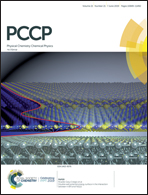Furthering the reaction mechanism of cationic vanadium clusters towards oxygen†
Abstract
Vanadium is a polyvalent metallic element. The fact that V–O bears a much larger bond energy than the V–V metal bond challenges the preparation of pure vanadium clusters and the observation of their reactions with oxygen-containing chemicals. Utilizing a customized reflection time-of-flight mass spectrometer (Re-TOFMS), here we have prepared well-resolved small and large cationic vanadium clusters Vn+ (n < 30), and we conducted a comprehensive study on their reactivity with oxygen. It is illustrated that cationic Vn+ clusters readily react with oxygen leading to the production of both etched building blocks and oxygen-rich VnOm+ (n < m) species profiting from the ion–molecule attraction and hence increased collisional cross section. Furthermore, DFT-based energy calculations reveal that the oxygen-addition reactions are thermodynamically and kinetically favorable pathways. Also the generalized charge decomposition analysis (GCDA) illustrates that the ion–molecule charge-transfer interactions initiate the incorporation of vanadium oxides. This finding of synchronous channels of both etching and growth of vanadium clusters clarifies the reactivity of Vn+ clusters with oxygen, interprets the readily formed VnOm+ clusters within the classification of the CxAyBz series (A = VO2, B = VO3, C = VO), and enriches the understanding of the industrial chemistry of vanadium.



 Please wait while we load your content...
Please wait while we load your content...